The earliest version of this card, the Cary-Yale (middle below, shows a lady holding open a rather fish-like lion's mouth. The image is taken from a common medieval representation of the virtue Fortitude; at left below is one from Chartres Cathedral (I get it from Flornoy, Pelerinage de l'ame).. A variation is the card from the deck that immediately followed in Milan, although this card was an addition done c. 1470. This version seems to me closest to the image in the Heilege Dreifaltigkeit that I showed in connection with the Wheel card, which was of a person praying while an executioner is aiming a sword at the person's neck.
The previous idea, of the lady with the lion, is repeated in the Noblet (below left) and other "Marseille" type decks, including the Conver (below right). The early lists in the late 15th and early 16th century all have "Fortitude" as the title of the card, but if you look at the poems in which many of these lists are imbedded, you will see that the sense is "Strength." Apparently, the word "Fortitudo" could mean both physical and moral strength.
From an alchemical perspective, my view is that the lion in the tarot Strength card represents the alchemist's fire, the one that melts the substances so that they can merge, boil off, etc. Leo in astrology is a fire-sign.
It is a matter of controlling that fire, so that it won't cause his materials to blow up in his face, but on the other hand also accomplish the transformations needed. According to de Rola (Golden Game p. 114), the one who invented a means of keeping the heat gentle and preventing it from boiling was Maria Prophetess, pictured below, from Maier's Symbola. She is credited with the invention of what de Role calls the water bath; still called the bain-marie in French. Presumably he means a type of double-boiler, since that is what the bain-marie consists of (http://en.wikipedia.org/wiki/Bain-marie). We are now, then, in a phase of gentle heat. The alchemical equivalent of the double boiler is a notable way of accomplishing this task.
Psychologically fire would mean strong emotion: anger, especially. Anger is a powerful motivator, both in oneself and towards others, but it also has great potential for harm.
Besides this interpretation as fire, there are specific references to lions in alchemical writings and pictures that suggest another interpretation (or perhaps refinements in what I have already said). O'Neill refers us to a late alchemical image that portrays a lion being devoured by a toad and being absorbed into a set of concentric circles that suggest the moon (Plates 14 and 15 of Johann Barchusen, Elementa chemiae 1718. Scanned from Fabricius, Alchemy, fig. 105, p. 64.)
The text that inspired the scene on the right (Crowne of Nature, early 17th century, p. 8, as quoted and dated by Fabricius, p. 64) says:
The text is derivative from the Rosarium Philosophorum, which existed in manuscript before 1400. Its 1550 printed version, which I may have shown earlier in this thread, had a woodcut of a naked man and woman copulating in a bath, followed in the next image by a double-headed corpse in a tomb.Joyne therefore (as yt is in the rosary) the most belowed sonn Gabricum with his sister Belia, to whome he gives all that he hath because he came from her. Whence yt may be gathered that without copulation there can be noe pregnacion, and without pregnacion not birth.
In Ripley's Cantilena, another Arnuldian text, an old king was absorbed into his mother's womb during copulation. In the image above, it is a lion being absorbed, with the toad and the circles as representatives of this feminine substance. The lion is merely the old king in animal form. It is as Jung said in his commentary on the Cantilena,
However in the Cantilena (late 15th century), the figure of the lion appears later, and is called "a Lyon Greene," sitting on its mother's lap and drinking her milk, while she drinks his blood.We would probably not be wrong if we assume that the "king of Beasts," known even in Hellenistic times as a transformation stage of Helios, represents the old king, the Antiquus dierum of the Cantilena, in a certain stage of renewal, and that perhaps in this way he acquired the singular title of "Leo antiquus." (Jung, Mysterium Coniunctionis p. 297).
This lion is an image of Christ, as Jung points out. Jesus in Christianity (Rev. 5:5) is called "The Lion of Judah" (http://en.wikipedia.org/wiki/Lion_of_Judah).A Lyon Greene did in her Lapp reside
(The which an Eagle fed), and from his side
The Blood gush'd out: The Virgin drunck it upp,
While Mecuries Hand did the Office of a Cupp. (Verse 31, quoted in Jung, Mysterium Coniunctionus p. 323. )
The old king, I infer, is the alchemical version of the God of the Old Testament, transformed by birth in the Virgin. The Old Testament God is the king before transformation, and also the lion before transformation. Jung says
There is similarly the lion side of God, who has a temper tantrum when Adam and Eve disobey him, and so on. It is the same with men (and women) in real life, to the extent that they exercise authority over others.The animal form emphasizes that the king is overpowered or overlaid by his animal side and consequently expresses himself only in animal reactions, which are nothing but emotions. (Jung Mysterium Coniunctionus p. 297.)
Jung also refers to a tale in the De Alchimia of "Senior," the Arab alchemist, called "The Lion Hunt." Here is Jung's summary:
The woman is lying on a bed of coals; so she is the retort or its contents. It is the same as in the Cantilena, with a lion in the place of the old king.Marchos prepares a trap and the lion, attracted by the sweet smell of a stone that is obviously an eye-charm, [Footnote: "The stone which he who knows, places on his eyes"], falls into it and is swallowed by the magic stone. "And this stone, which the lion loves, is a woman." (Mysterium Coniunctionus p. 298f)
O'Neill refers us to other images, this time from Mylius's Philosophia Reformata 1622. Here is one (Emblem 17, in Fabricius fig. 105, p. 163).

O'Neill comments:
That for sure is how the lion ends up in the images he refers us to. I am not sure that absorbing the lion, leading to his death (psychologically, the death of that way of being) is gentle; but the later stage, Ripley's image of the Virgin suckling the newborn. is gentle enough.The overcoming of the instincts, the raw matter in the man, cannot be done by brute strength. It requires a woman's touch, gentle and persistent. Eventually, the ferocity of the lion will disappear and the maiden may even ride him or conduct him about on a leash. (Tarot Symbolism p. 179).
My guess about the lion is that as the masculine form of alchemical "mercury," it also referred to the chemical sulfur, which, like mercury, could act as a deadly poison. So we have the poisonous snake and the lion, two forms of the same thing. How "sulphur" gets assimilated to "mercury" I think is as follows. Mercury was used to separate metals from their until sulfuric acid came along; hence their equivalence. Sulfur, the chemical element, in contact with water, as in a paper mill, or in human bodies, becomes a corrosive acid, good for dissolving wood or ore, but poisonous. Yet sulfur, like mercury, was also a key ingredient in some medicines, and in the mineral springs people went to for cures. When the alchemists, stumbling around with these compounds, got something in their laboratory that seemed to cure illness, they thought they were close to making the elixir.
There is an analogy to the Christian God. If you run afoul of him, you will know death, as loss of immortality and as being sent to hell. Similarly, sulfur (the chemical element) when ingested improperly, as poison, causes suffering and death. But sulfur in the right form and amount cures illness and so frees one temporarily from death. Sulfur has its laws just as God does. It is the same as with fire, which kills when uncontrolled but also is an agent of life-sustaining warmth and nurturing chemical transformation.
12. The Alchemical Hanged Man: wanting to go up, but going down.
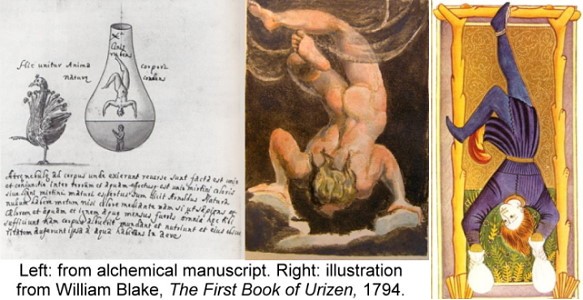
One early alchemical image (above left; Laurinda Dixon, Bosch, from ms. 29, Wellcome Institute) associates the image of an upside down man with the process of distillation. The substance to be distilled was first in solution, then with heat converted to a gas. In non-alchemical contexts, the substance released was often alcohol, which cooled and collected in coiled tubing leading to a different container. The result was a higher concentration of alcohol in the liquid. For the alchemists, the process would have been purification through repeated attainment of the gaseous state. Anyone who breathed the alcohol-rich fumes was easily inebriated. A similar effect might have been produced by hyperventilating or hanging upside-down. Dixon associates the alchemical image with ones in Bosch's Garden of Earthly Delights of men hanging upside-down and appearing in ecstatic states. Such a "high," without the alcohol but with whatever substance was in the berries his people are shown eating.

The alchemists' association with the gaseous state, i.e. entering the element of Air, seems to have been known by William Blake, who used a similar image to that of the alchemists in his personification of the element of Air in his Book of Urizen (at least David Erdman, The Illuminated Blake, p. 196, says it is what we are seeing, top of post, right). The personification is named Thuriel, one of the four "sons of Urizen."
The Charles VI Hanged Man's (at right above) adoption of the same leg positions may originally have derived from the same tradition, suggesting purification. But the addition of the money bags makes it something else, a Judas figure, which is alchemical only with great difficulty. I will discuss that view at the end of this post.
Now I want to built on some remarks of O'Neill's about some alchemical texts. Looking at the two poles as trees, he refers to images of alchemists in trees, or even becoming trees. He sees trees as maternal images; to be in or turning into a tree is then equivalent to Attis emasculating himself at the base of a symbol of the Great Mother. However, trees were a common medieval image; climbing a tree was like climbing a ladder, meaning a spiritual ascent.
O'Neill relates the Hanged Man to a short medieval poem, the "Epigram of the Hermaphrodite}, an alchemical allegory of about 1150 (Tarot Symbolism p. 281). Jung quoted it in paragraph 89 of Mysterium Coniunctionis and attributed it to Mathieu de Vendome (ca. 1150). Jung found it in Lorichius, Aenigmatum libri III, fol. 23r, Frankfurt 1545:
When my pregnant mother bore me in her womb,
they said she asked the gods what she would bear.
A boy, said Phoebus, a girl, said Mars, neither, said Juno.
And when I was born, I was a hermaphrodite.
Asked how I was to meet my end, the goddess replied: By arms;
Mars: on the cross; Phoebus: By water. All were right.
A tree overshadowed the waters, I climbed it;
the sword I had with me slipped, and I with it.
My foot caught in the branches, my head hung down in the stream;
And I--male, female, and neither--suffered by water, weapon, and cross.
Since the poem has to do with the hermaphrodite, O'Neill, like Jung, considers it an alchemical poem. O'Neill connects it with an alchemical image of the alchemist confronting himself, or a fellow alchemist, hanging upside down in a tree (at left below). (Images from Johann Daniel Mylius, Opus medico-chymicum, 1618. In de Rola, Golden Game p. 144, or Fabricius, Alchemy fig. 29, p. 20. De Rola's translation of mottos is on his p. 152.)

According to de Rola, the motto of the first image is "This knowledge requires a true Philosopher not a foolish one." The second image, like the first one, suggests peril. As Marco pointed out to me on Tarot History Foru, the upside down alchemist is the one who tries to accomplish the work on his own. The other, climbing up,is relying on the help of the angels. The moral, according to the words around the circle is, "It is not for Man's industry alone, but in God's hands, to will and encompass All in All." In other words, success is up to God and not man.
O"Neill concludes that from an alchemical perspective
What O'Neill, and Jung before him, had in mind is a kind of imitatio Christi in which the alchemist experiences rejection and failure, leading to death. It is like Christ on the cross saying "My God, My God, why hast thou forsaken me?" The alchemical poem explicitly brings out the analogy, in saying that the hermaphrodite is dying on the cross. The cross of the crucifixion was commonly referred to as a tree.The Hanged Man basically represents the intensification of the blackening stage which began with the Hermit. The glory of the first coniunctio has faded into darkness and despair...Now at last he is ready for the total surrender which is implied in the Hanged Man. ... The Hanged Man is the stage of surrender which prepares the alchemist for the mystical death which follows" (p. 282).
I agree with this line of thinking. However it is a state of intense connection with the other world as well as despair in this one. It is like the state of the visionary melancholic that I discussed in connection with the Hermit, but more intense.

Along the same lines as O'Neill, another detail on the card interests me: the hole into which his head extends. This hole exists on all the Milan-descended images, from the PMB (at right above) to the Cary Sheet (at left, all that is preserved of it) to the various Marseille-style images (for Noblet and Dodal, I am using Flornoy's restorations, because I want to make a point later about the colors, which have faded on the originals). It seems to me that the Hanged Man is like a seed being planted in the earth. It is the death that will bear rich fruit. Alchemical images make this same comparison, for example (Upper image from Mylius, Philosophia Reformata, 1622, emblem 14. In de Rola p. 171. Lower image from Michael Maier, Tripus aureus 1618. In de Rola p. 122. De Rola's discussion is on his p. 125f).
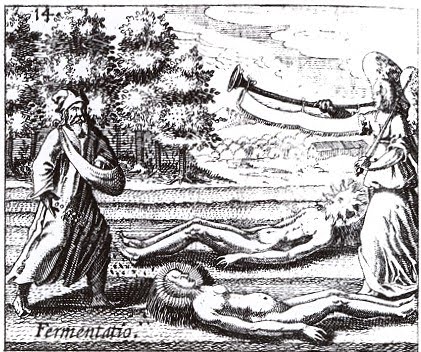
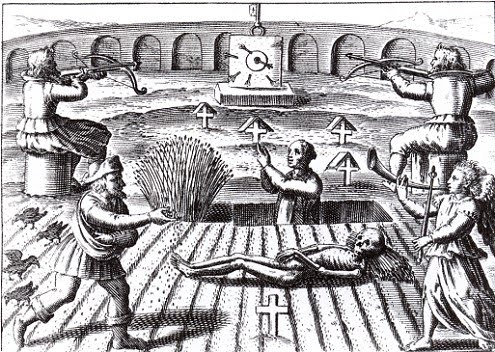
In both images, the stage of the work is that called "fermentation." A dead seed in the earth will bring forth new life, as something that will happen to it rather than its birthing itself by its own efforts. In the second image above, notice the shape of the crosses on the graves: a triangle on top of a cross. In alchemy a similar shape, but with the triangle inverted, is the symbol for sulphur, the masculine principle, to which the tarot Emperor also conforms.

The Hanged Man, if we consider just his legs and his torso, is merely the Emperor upside down--also younger and without the Emperor's beard, but usually, in the Marseille versions, with the same color leggings, including the same different colors when they are different from each other. Below I have situated the three "Marseille" Emperors in the same order as earlier I put the "Marseille" Hanged Men.

I looked up sulfur--the real chemical, not the "philosophical" one--on the Internet. It is a vital ingredient in plants, and the soil naturally does not have enough of it. Adding sulphur compounds to the soil promotes the development of the young plants. So there is a genuine chemical basis for the symbolism. Putting the Emperor in the soil brings about new life.
In the PMB, correspondingly, the Hanged Man has green leggings, the same green as on the PMB female Lover's sleeve, the Empress's, the Queen of Cups', and those of all the court figures in Batons. Green in the PMB is a fertility symbol.
In connection with these images, De Rola cites two biblical verses that connect well to this aspect of the Hanged Man:
(One slight correction: The sense of the last three words should be "its own body," as in Douhay-Rheims and other translations since the King James.) De Rola observes that from these verses came the alchemical axiom, "No generation without prior corruption. " Even then, what happens is in God's hands. By ourselves, we are simply dead. Then the hermaphroditic Mercury impaled on the tree is a symbol not just of a tortuous death, but of the resurrection to come, made possible by Jesus's death, which is what the PMB figure is, with his green leggings, and the Marseille as well, more ambiguously."Verily, verily I say unto you, Except a corn of wheat fall into the ground and die, it abideth alone: but if it die, it bringeth forth much fruit." (John 12:24).
"Thou fool, that which thou sowest is not quickened, except it die: and that which thou sowest, thou sowest not that body that shall be, but bare grain, it may chance of wheat, or of some other grain: But God giveth it a body as it hath pleased him, and to every seed his own body." (I Corinthians 15.36-38).
I know that this card was the card of the traitor, the twelfth card for the twelfth apostle. But in the case of the PMB, there is a twist. This card was almost certainly made for the Sforza children, and their own grandfather famously had had a shame poster made for him, by the anti-Pope John XXII. {This was fairly clearly verified on a different thread on THF recently.) Sometimes the good guys get shamed. Jesus, too, was considered a traitor by the Sanhedrin. It seems to me that there are enough indicators on the "Marseille" cards to suppose that this interpretation was maintained in the transposition to France: the hole in the ground, the halo-like hair, sometimes a dead tree on one side and a living one on the other, sometimes green leggings, sometimes blood-like ends on the lopped off branches. One can even imagine, as Camoin does (http://en.camoin.com/tarot/Jacobs-Ladde ... Tarot.html), boards held in place by the stubs of the branches, making a "Jacob's ladder" to the stars. But unlike in Camoin's story, in alchemy to go up you first have to go down.

The Charles VI, and the others who clutch their money bags, follow a different tradition, not of the Sforza: there is no hole in the ground either. I am not talking about these, which wish us to think of the Hanged Man as Judas. Their pieces of silver will not turn to gold. Despite the twisted leg, the relationship to the alchemical model has been broken. It is possible that by some Judas himself was considered a voluntary sacrifice for the redemption of humanity, by setting in motion Jesus's own sacrifice. But this would not have been a generally understood meaning, even among an esoteric group; it is too opposed to the dogma of the Church. It is one of those ancient heresies that Irenaeus had exposed (http://www.gnosis.org/library/advh1.htm, XXXI.1).
12 Alchemical Death: not just death but dismemberment, and entering the darkness
Here are two early Death cards, from the Cary-Yale 1440s and the PMB, 1450s..
Both the reaper and the archer were common images of death in the 15th century and before. O'Neill (Tarot Symbolism p. 282) observes that there are similarities between the figure of Death on the card and the alchemical image of Saturn. Saturn often carries a scythe, in non-alchemical as well as alchemical contexts. For example, there is the image below, from Jung's Psychology and Alchemy.
Moreover, both Saturn and Death are associated with the nigredo, or blackening; black is the coor of death, and so of mouring; thus we see death with objects of mournng, as below (above, Mylius, Philosophia Reformata 1622, Emblem 6; in Fabricius, Alchemy fig. 173, p. 102). The figure on the left is probably Saturn, who was sometimes portrayed with a lame or amputated leg.

Death as a skeleton occurs on many alchemical illustrations.. It is what all the cards from the Hermit after have been leading up to. However in alchemy the image of death typically occurs much earlier than in the tarot, right after the coniunctio in fact. Death of an old form is what makes possible the transmutation into a higher form; and since there is more than one transmutation, death must occur more than once. The tarot, more in line with Christian dogma, simplifies the process. In the Marseille cards, we see heads sticking up like sprouts, looking alert; they are perhaps fearful, but don't seem dead; we see the new beings already being formed. they are the natural successor to the Hanged Man: once put in the earth, the spirit rises again.

The various other body parts suggest "the limbs of Osiris" in Plutarch. In this scenario, the reaper merely clears the weeds.
For further amplification, I will show again the illustration of three forms of execution, from the Heilege Dreifaltigkeit. Instead of a scythe, we have a sword. The introduction to the book advertises that "He who from this book of God hears well, and follows it rightly, will get from it rich pay, both silver and also the noblest red gold." Since gold is not red, it may be that the author is implying spiritual gold, of the rising sun. (Image from Laurinda Dixon, Bosch p. 269. Text from http://www.alchemywebsite.com/f1-50html.)

Earlier in this blog I showed several other early alchemical illustrations (c. 1420 or earlier) implying the death of the subject: the eight or nine eagles pointing their arrows at the king or alchemist, in vat. palat. 1066 and the Aurora Consurgens; Phaeton being helped into his tomb in palat. 1066; the serpent-lady aiming her spear at Adam in the Dresden Heilegen Dreifaltigkeit. (For examples, see viewtopic.php?f=11&t=647&start=0#p10405 and viewtopic.php?f=11&t=647&start=0#p9870.)
By the 17th century, if not before (e.g. palat. 1066, where the text is a Christian moralization of Greek myth), the alchemists were explicitly relating alchemy to Greek and Egyptian myth. One myth relating to death was that of Osiris's, not only hia death but his resurrection, as told by Plutarch in Isis and Osiris (http://thriceholy.net/Texts/Isis.html. XVIII). Emblem XLIV of Michael Maier's Atalanta Fugiens portrays this scene (below). The motto reads "By treachery Typhon slays Osiris and scatters his limbs abroad, but majestic Isis reassembles them" (De Rola Golden Game p. 93), So in the emblem we see the dismembering first, then a scene that looks much like a Christian Eucharist, suggesting that to the alchemists the death and resurrection of Osiris prefigured that of Christ. The scene of Isiris in the chest could either be Osiris resurrected after his dismemberment, or Osiris earlier, getting into the coffin that Seth had prepared, with the conspirators exclaiming how well it fits him( Isis and Osiris XIII). Then they will shut the lid and throw it in the Nile. His body will float out to see until it comes ashore at Byblus, where a mighty tree will grow around it, found by Isis.

The enclosure of Osiris in a casket is reminiscent of another depiction of alchemical death, that of Lambspring Emblem 13, in which a young man enters his father's mouth and is swallowed by him. Below is the image, with a few lines of the accompanying verses:
Versions of another story in Plutarch (http://thriceholy.net/Texts/Isis.html, XVI), that of Isis burning her foster-child at Byblus in a fire at night to make him immortal, also were used in alchemical illustrations. In Emblem XXXV of Atalanta Fugiens, Maier shows on the left Ceres with Triptolemus and on the right Thetis with Achilles. The motto is "As Ceres made Triptolemus--and Thetis made Achilles--able to stay in the fire, so the Artist makes the Stone" (De Rola Golden Game p. 88)
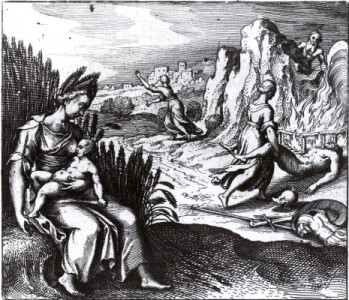
Maier explains (http://www.alchemywebsite.com/atl31-4.html):
Since Maier cites Arnold in the Rosarium, the idea of comparing the burning subject to an infant at the breast by day and in fire by night must have already existed when the tarot was born....It is by much Use and Custom that the Philosophers fix their Stone in Fire proper for it..Arnold in the Rosary, Book 2 Chapter 7 says, "Yet the Medicine must be long time roasted by Fire and nourished as a child by the breast." The Ancient Philosophers would demonstrate these very things by the Allegories of Triptolemus and Achilles, and their lyeing under Fires to be hardened by them, since each of them denote nothing Else but the Chemicall Subject,...Ceres as a Nurse nourished Triptolemus all day with her milk and at night placed him in the Fires, by which means the boy being very well grown...Achilles is likewise said to be hardened by his Mother after the same manner as Triptolemus was before...De Rola Golden Game p. 88
Maier sees the myth of burning something in a high heat as a stage in "fixing" the Stone so as to make it the elixir. It is perhaps like taking arsenic in small doses that increase over time, which provides one with immunity against a dose that would be lethal otherwise. A metallurgical metaphor might be the process of making iron into steel by burning it with charcoal, hardening it by means of fire and carbon. One important aspect of the fire, here, I think, is that is high heat, not the gentle heat of the double boiler,the bain marie.
14, Alchemical Temperance: circulation of fluids from above to below, and avoiding extremes.
Here are some early images of Temperance,
The Temperance angel's jugs correspond, in alchemy to the vessels used in the distillation process. With the application of heat, substances turn gaseous, go up the tube, and condense in the upper flask. Pictures of the process occur as far back as there are surviving alchemical manuscripts, for example this page of the Dresden Heilege Dreifaltigkeit, c. 1450.

Here what O'Neill says is very much to the point:
If you heat wine below the boiling point of water, but above the boiling point of alcohol, you will get more alcohol than water flowing out of the top as a result. That is more of the essence of Dionysus and that much closer to the sought-after elixir. But the alchemists were concerned with a more elusive chemical than alcohol, called "philosophical Mercury." In this context, the winged lady becomes the soror mystica of the alchemist. Female figures were often shown pouring liquids together with the alchemist, for example (from the Mutus Liber of 1677):The stone cycles between solid (matter) and gas (spirit). The vessel is raised to white heat by the internal conflict and struggles. The stone rises in the retort. When it strikes the cooler upper portions, it condenses and falls. The pouring of water between the two ewers on the Temperance card suggests the same process. (Tarot Symbolism p. 283)
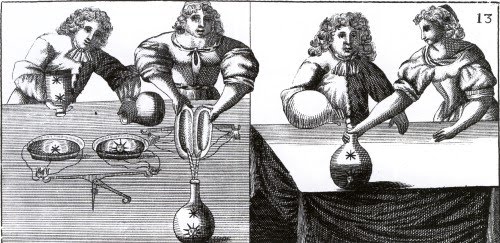
O'Neill 's example is the one below, from Maier's Symbolae aurae mensae of 1617; he compares her specifically to the "angel" on the card.

The female figure is identified in the alchemical text as Maria Prophetess. She might qualify as a female guide in the work, even to worlds beyond this one, but I do not see how she is meant as an angel, given the tradition that. Zosimos of Panapolis in the third century identified her as the sister of Moses.
Fabricius (p. 129) applies a quote in the Rosarium from the arab alchemist known as "Senior" to this image:
The upper fume descends to the lower fume and one fume conceives by the other fume.The descent of the volatile to the fixed that is shown in the Temperance card is also a new coniunctio resulting in a new being, who will then rise again in the retort.
De Rola's analysis of the picture is as follows:
I will discuss the second sentence later, in connection with the World card. De Rola's analysis of the first sentence very much corresponds to what O'Neill describes in more psychological language. The Temperance lady is showing us one of the main tools of the alchemist, with which success is possible. She is also one out of several representations of a female psychopomp leading us through an initiatory sequence.The Mountain, in alchemical symbolism, is the Materia Prima, which must first be reincrudated, "made green again," in order to produce the desired results. The fumes rising and falling between the vessels symbolize the circular process of Dissolution and Fixation (Solve et Coagula), preceding the birth of the Quintessence--five flowers on a single stem.








how interesting are your articles. Thanks for sharing them.
ReplyDelete